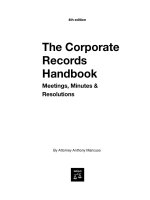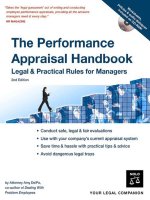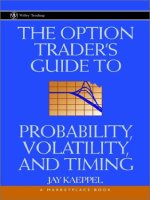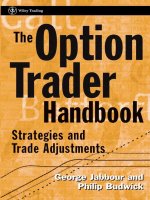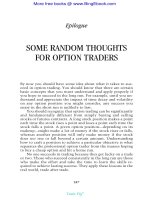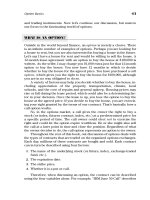the option trader handbook - strategies and trade adjustments
Bạn đang xem bản rút gọn của tài liệu. Xem và tải ngay bản đầy đủ của tài liệu tại đây (1.15 MB, 355 trang )
The Option
Trader
Handbook
Strategies and
Trade Adjustments
GEORGE M. JABBOUR, PhD
PHILIP H. BUDWICK, MsF
John Wiley & Sons, Inc.
1029G_fm_i-xiv.qxd 3/11/04 17:23 Page iii
1029G_fm_i-xiv.qxd 3/11/04 17:23 Page x
The Option
Trader
Handbook
1029G_fm_i-xiv.qxd 3/11/04 17:23 Page i
Founded in 1807, John Wiley & Sons is the oldest independent
publishing company in the United States. With offices in North America,
Europe, Australia and Asia, Wiley is globally committed to developing
and marketing print and electronic products and services for our cus-
tomers’ professional and personal knowledge and understanding.
The Wiley Trading series features books by traders who have sur-
vived the market’s ever changing temperament and have prospered—
some by reinventing systems, others by getting back to basics. Whether
a novice trader, professional or somewhere in-between, these books
will provide the advice and strategies needed to prosper today and
well into the future.
For a list of available titles, please visit our Web site at
www.WileyFinance.com.
1029G_fm_i-xiv.qxd 3/11/04 17:23 Page ii
The Option
Trader
Handbook
Strategies and
Trade Adjustments
GEORGE M. JABBOUR, PhD
PHILIP H. BUDWICK, MsF
John Wiley & Sons, Inc.
1029G_fm_i-xiv.qxd 3/11/04 17:23 Page iii
Copyright © 2004 by George Jabbour and Philip Budwick All rights reserved.
Published by John Wiley & Sons, Inc., Hoboken, New Jersey
Published simultaneously in Canada
No part of this publication may be reproduced, stored in a retrieval system, or transmitted
in any form or by any means, electronic, mechanical, photocopying, recording, scanning,
or otherwise, except as permitted under Section 107 or 108 of the 1976 United States
Copyright Act, without either the prior written permission of the Publisher, or
authorization through payment of the appropriate per-copy fee to the Copyright Clearance
Center, Inc., 222 Rosewood Drive, Danvers, MA 01923, 978-750-8400, fax 978-750-4470, or
addressed to the Permissions Department, John Wiley & Sons, Inc., 111 River Street,
Hoboken, NJ 07030, 201-748-6011, fax 201-748-6008.
Limit of Liability/Disclaimer of Warranty: While the publisher and authors have used their
best efforts in preparing this book, they make no representations or warranties with
respect to the accuracy or completeness of the contents of this book and specifically
disclaim any implied warranties of merchantability or fitness for a particular purpose. No
warranty may be created or extended by sales representatives or written sales materials.
The advice and strategies contained herein may not be suitable for your situation. You
should consult with a professional where appropriate. Neither the publisher nor author
shall be liable for any loss of profit or any other commercial damages, including but not
limited to special, incidental, consequential, or other damages.
For general information on our other products and services, or technical support, please
contact our Customer Care Department within the United States at 800-762-2974, outside
the United States at 317-572-3993 or fax 317-572-4002.
Wiley also publishes its books in a variety of electronic formats. Some content that
appears in print may not be available in electronic books.
Library of Congress Cataloging-in-Publication Data:
Jabbour, George (George Moussa)
The option trader handbook : strategies and trade adjustments / George
Jabbour, Philip Budwick.
P. cm.
ISBN 0–471–56707–8 (cloth : alk. paper)
1. Options (Finance) 2. Options (Finance)—Prices. 3. Stock
options. I. Budwick, Philip. II. Title.
HG6024.A3 J32 2004
332.64'53—dc22
2003026646
Printed in the United States of America
10987654321
1029G_fm_i-xiv.qxd 3/11/04 17:23 Page iv
on the web at www. copyright.com. Requests to the Publisher for permission should be
For more information about Wiley products, visit our web site at www.wiley.com.
v
Preface xi
CHAPTER 1 Trade and Risk Management 1
Introduction 1
The Philosophy of Risk 2
Truth about Reward 5
Risk Management 7
Risk 7
Reward 10
Breakeven Points 11
Trade Management 12
Trading Theme 12
The Theme of Your Portfolio 15
Diversification and Flexibility 16
Trading as a Business 16
Start-Up Phase 17
Growth Phase 20
Mature Phase 20
Just Business, Nothing Personal 21
SCORE—The Formula for Trading Success 22
Select the Investment 22
Choose the Best Strategy 24
Open the Trade with a Plan 24
Remember Your Plan and Stick to It 26
Exit Your Trade 27
CHAPTER 2 Tools of the Trader 29
Introduction 29
Option Value 30
Contents
1029G_fm_i-xiv.qxd 3/11/04 17:23 Page v
vi CONTENTS
Option Pricing 31
Stock Price 32
Strike Price 32
Time to Expiration 32
Volatility 32
Dividends 33
Interest Rates 33
Time Value Premium 33
Time Decay 33
Early Assignment 36
Implied Volatility 38
Synthetic Positions 41
Synthetic Stock 42
Synthetic Call 44
Synthetic Put 46
Basic Strategies 47
Long Call 47
Short Call 48
Long Put 48
Short Put 50
Basic Spreads and Combinations 50
Bull Call Spread 51
Bull Put Spread 51
Bear Put Spread 52
Bear Call Spread 53
Long Straddle 54
Long Strangle 54
Short Straddle 56
Short Strangle 57
Advanced Spreads 58
Call Ratio Spread 58
Put Ratio Spread 59
Call Ratio Backspread 60
Put Ratio Backspread 61
Long Butterflies 62
Short Butterflies 63
CHAPTER 3 Long Stock 65
Introduction 65
Protective Put 66
Stock Moves Higher 69
Stock Moves Lower 71
1029G_fm_i-xiv.qxd 3/11/04 17:23 Page vi
Contents vii
Bear Put Spread 74
Rolling from a Protective Put into a Bear Put Spread 76
Rolling from a Bear Put Spread into a Protective Put 78
Call Replacement 80
Stock Moves Higher 81
Stock Moves Lower 82
Call Replacement versus Protective Put 83
Sell Covered Calls 83
Stock Moves Higher 85
Strike Selection 87
In the Money Calls 88
Time to Expiration 91
Scaling-Out Strategy 92
Collars 94
Opening Position—Regular Collar 94
Stock Moves Higher—Profit Collar 97
Ratio Write 100
Opening Position 101
Stock Moves Higher—Regular Ratio Write 103
Stock Moves Higher—Variable Strike Ratio Write 110
Stock Moves Lower—Ratio Write/Variable Strike Ratio Write 114
Short Straddle/Short Strangle 117
Opening Position—Short Straddle 117
Opening Position—Short Strangle 121
Stock Moves Higher—Short Straddle 123
Stock Moves Higher—Short Strangle 129
Stock Moves Lower—Short Straddle/Stock Repair 133
Stock Moves Lower—Short Strangle 137
Call Ratio Spread 140
Opening Position 143
Stock Moves Higher 147
Stock Moves Lower—Stock Repair Strategy 152
Call Calendar Spread 155
Opening Position 156
Stock Moves Higher 158
CHAPTER 4 Short Stock 163
Introduction 163
Protective Call—Insurance 165
Opening Position—Protective Call 165
Opening Position—Protective Call Spread 170
Short Stock ϩ Protective Call ϭ Long Put 172
1029G_fm_i-xiv.qxd 3/11/04 17:23 Page vii
viii CONTENTS
Stock Moves Lower—Protective Call 174
Stock Moves Lower—Protective Call Spread 177
Rolling between Protective Calls and Protective Call Spreads 181
Stock Moves Higher 183
Put Replacement 185
Stock Moves Lower 186
Stock Moves Higher 188
Put Replacement versus Protective Call 189
Covered Puts 190
Stock Moves Lower 191
Short Collars 196
Opening Position—Regular Collar 197
Stock Moves Lower—Profit Collar 199
Put Ratio Write 201
Opening Position 202
Stock Moves Lower—Regular Ratio Write 205
Stock Moves Lower—Variable Strike Ratio Write 210
Put Ratio Spread 212
Opening Position 212
Stock Moves Lower 215
Stock Moves Higher—Short Repair Strategy 218
CHAPTER 5 Calls and Puts 221
Introduction 221
Long Call 222
Protective Put—Stock Moves Higher 222
Protective Put—Stock Moves Lower 224
Call Replacement 226
Rolling into a Bull Call Spread—Stock Moves Higher 229
Rolling into a Bull Call Spread—Stock Moves Lower/Call
Repair Strategy 231
Rolling into a Bear Call Spread 232
Short Stock 235
Rolling into a Synthetic Straddle 236
Rolling into a Calendar Spread 237
Rolling into a Ratio Spread 240
Stock Moves Lower—Call Repair Strategy 244
Short Call 248
Long Put 249
Protective Call 250
Put Replacement Therapy 253
1029G_fm_i-xiv.qxd 3/11/04 17:23 Page viii
Contents ix
Rolling into a Bear Put Spread 255
Rolling into a Bull Put Spread 259
Long Stock/Synthetic Straddle 260
Put Calendar Spread 265
Put Ratio Spread 267
Short Put 273
CHAPTER 6 Spreads 277
Introduction 277
Bull Call Spreads/Bear Put Spreads 277
Protective Puts/Protective Calls 278
Convert to Ratio Spreads 283
Convert to Butterflies 297
Bear Call Spreads/Bull Put Spreads 300
Calendar Spreads 301
Call Calendar Spread 301
Put Calendar Spread 305
CHAPTER 7 Combinations 311
Introduction 311
Long Straddle 311
Straps/Strips 312
Modified Straps/Strips 315
Calendar Straddle 318
Rolling a Long Straddle into an Iron Butterfly 320
Diagonal Iron Butterfly 321
Partial Iron Butterfly 322
Long Call/Long Put Adjustments 323
Long Strangle 323
Diagonal Iron Butterfly 324
Calendar Strangle 325
Long Call/Long Put Adjustments 326
Short Straddle/Short Strangle 326
Short Straddle 327
Short Strangle 329
Index 331
1029G_fm_i-xiv.qxd 3/11/04 17:23 Page ix
1029G_fm_i-xiv.qxd 3/11/04 17:23 Page x
xi
O
ption trading is both an art and a science. The science of option
trading is very straightforward and mechanical and involves the
specific steps in establishing a position, pricing, and understand-
ing how movements in the underlying stock affect your trades. The art of
trading, on the other hand, involves the use of your imagination and inge-
nuity. The market is your canvass and you coordinate different strate-
gies and adjustments to create a unique painting, which is your portfolio.
As mechanical as option trading seems, to be truly successful you will
need to apply your own artistic style with respect to developing strate-
gies and making trade adjustments. This book is about the art of making
trade adjustments.
Making an adjustment to a stock or option position is one of the most
overlooked and underutilized skills in trading. Moreover, it is one area
where your personal style and imagination are valued over any other
quantitative trading skill. Options give you the flexibility to trade markets
in any direction, or with no direction at all, and for as long or as short a
time period as you want. Just as eight simple musical notes can be com-
bined to make an infinite number of symphonies and songs, calls and puts
also can be combined in a number of ways, using different expiration
dates and strike prices, to create an almost infinite number of positions
and follow-up adjustments.
Using the right trade adjustment can hedge or even boost your profits,
limit your losses, and create risk-free trades. Trade adjustments can also
be used to repair losing positions. Whether you invest using only stocks,
only options, or both, the information in this book is intended to give you
the tools you need to improve your trading skills and performance.
The material in this book presents the art of trade adjustments in a
logical sequential order. First, we discuss the most important aspect of
investing—risk and trade management. Trade adjustments are tools used
to implement trade and risk management. Therefore, you cannot under-
stand how to use the tools if you are not aware of the theory behind them.
That is why in the first chapter we present the guiding principles of risk
and trade management and describe how to apply them to manage your
Preface
1029G_fm_i-xiv.qxd 3/11/04 17:23 Page xi
xii PREFACE
portfolio. We discuss investment and portfolio themes and how to
develop a professional approach to your trading. Finally, we detail our
formula for trading success, known as SCORE, which not only teaches
you how to incorporate our principles of risk and trade management into
your daily trading, but also lays out a complete step-by-step trading and
portfolio management system.
After you have learned the theory, you need to know the right tools
for effectively putting the theory into practice. Chapter 2 provides an
overview of the tools you will need to control your risk, take advantage
of the benefits of options, and make adjustments to your positions. This
book is not meant for the pure beginner in options; we assume that the
reader has a minimal understanding of how options work and a familiar-
ity with the basic strategies. Nonetheless, we provide a quick overview
of the most important characteristics of options and various strategies to
remind the reader of the terms and strategies that are used throughout
the book. The trade adjustments discussed range from basic to quite com-
plex. Therefore, a general background in option strategies is required and
presented in Chapter 2. We also discuss implied volatility and time decay,
two often overlooked option characteristics, which, if used effectively,
can reduce many common mistakes made by most traders.
Once you have learned the theory and the tools to put that theory
into practice, you are ready to learn the art of trade adjustments. The
remaining chapters discuss how to adjust various trading positions to
lock in a profit, hedge against a loss, or boost an overall profit. Each chap-
ter covers a different type of underlying position and all the possible
adjustments that can be made to that position, whether the underlying
stock moves higher or lower, or even if it moves sideways. We start with
long and short stock positions and the various adjustments you can make
using options. We also deal with basic and advanced call and put posi-
tions and cover adjustments to more advanced strategies such as spreads
and combinations.
The strategies and adjustments in the book continually build on infor-
mation presented in previous chapters. Therefore, you are encouraged to
read the book straight through because the strategies and adjustments
become more complex and follow a natural progression. However, most
traders will probably use the text as a reference handbook and go directly
to the chapter or strategy they are interested in reading about. In later
chapters you may find references to earlier chapters or find short sum-
maries of position analysis where the relevant background to a specific
strategy was presented earlier in the handbook.
We tried whenever possible to make it easy for the handbook users
to read up on the specific strategy they are interested in and find all the
information they need in one place. However, you will find that all
1029G_fm_i-xiv.qxd 3/11/04 17:23 Page xii
Preface xiii
the strategies and adjustments complement each other and you will gain
a better understanding of the art of trading by first reading the chapters
in order. Thereafter, you can keep the handbook at your side and use it
as a trading reference.
Within each chapter, we use numerous examples to demonstrate the
different trade adjustments using real stocks. The stocks used as exam-
ples are merely for illustrative purposes and in no way are to be construed
as an investment opinion on whether to buy or sell such securities.
Whenever we quote stock or option prices or specific strategy costs, we
are estimating the premiums on the given options based on market prices
at the time of writing for purposes of illustrating the given strategies and
adjustments. The prices quoted for each option are the assumed prices
you would hypothetically buy or sell those options for in each example
and we ignore bid/ask spreads.
When calculating the profit and loss for each strategy or adjustment
as well as for the risk/reward profile charts contained in each chapter, we
assume that the relevant options are at expiration and worth only their
intrinsic value, if any. The positions can be terminated at any time prior
to expiration either by closing the position or exercising the options.
However, the only time we know the exact value of the option is on its
expiration day, so we assume all positions are held to expiration. For
simplicity, the profit calculations also exclude commissions, taxes, and
other transaction costs as well as the effect of the time value of money.
When discussing option pricing in Chapter 2, we present the
Black–Scholes option pricing model merely for purposes of explaining
the different option pricing factors and how they affect the price of the
option. Although the formula assumes that the options are European
style, we apply the price sensitivity factors in the Black–Scholes model
to American-style equity options discussed in the handbook—to simplify
the explanation of how each pricing factor can affect the value of a call
or a put.
The number of possible trade adjustments to the positions we cover
in the handbook is almost infinite and we could not possibly cover every
single trading scenario or contingency. We try to present the best possi-
ble trade adjustments given the movement of the underlying stock and
even present some adjustments that we do not recommend, for the sake
of being as complete as possible. The number of possible adjustments
that can be made is limited only by your imagination, so feel free to take
what you read one step further whenever practical.
Moreover, there are some strategies to which we did not cover trade
adjustments. Because most complex option positions can be broken
down into more familiar simple strategies already covered in this hand-
book, you can easily take the adjustments covered here and apply them
1029G_fm_i-xiv.qxd 3/11/04 17:23 Page xiii
xiv PREFACE
to any option strategy. However, you should never overtrade your position
or make too many adjustments. Sometimes the best adjustment is clos-
ing out a profitable trade to realize your gain or closing out a losing posi-
tion to limit your loss. Therefore, the handbook is meant to teach you to
make appropriate trade adjustments and not overtrade positions by mak-
ing as many adjustments as possible.
This book is intended to be a tool for both stock and option traders.
Whatever strategy you are using, you can find numerous trade adjust-
ments for most situations. Making the right adjustment to your position
at the right time can improve your trading skills and performance. How-
ever, all skills take time to learn and the same is true with the art of trade
adjustments. Let your imagination be your guide, and this handbook will
become one of the most valuable assets in your portfolio.
1029G_fm_i-xiv.qxd 3/11/04 17:23 Page xiv
1
INTRODUCTION
When novices begin to learn martial arts or boxing, they invariably want
to start by learning how to punch or strike their opponent. To them, that
is the most exciting part of learning martial arts and they are in a rush
to learn to attack. However, the trainer or coach will usually start by
teaching them how to defend themselves or block an attack. If you cannot
defend yourself from getting hit, then you will not last long enough
to attack your opponent. Most novices fail to see the importance of defen-
sive techniques. In sports, the motto is that defense wins championships.
After all, even if you score points, you cannot win if you let your opponent
score more points against you.
The importance of defense is also true in option trading. Beginners
and advanced traders alike want to focus on trading strategies and mak-
ing money. They usually overlook the importance of defense. Of course
when trading options, we are not at risk of getting punched or attacked,
but the money we invest is under constant attack. We are competing with
thousands of traders and investors who want to “take” our money.
Investors and traders need to learn to defend their capital against losses
just like boxers need to protect their bodies and heads. Allowing too
many losses, or “attacks,” to your trading capital will leave you with no
money and you will be out of the trading game. Therefore, option
investors must also first focus on defense before jumping into the offense
of making trades or establishing positions.
The defensive skills that should be studied by any investor before
focusing on trading strategies are risk and trade management. Learning
CHAPTER 1
Trade and Risk
Management
1029G_c01_01-28.qxd 02/29/04 00:49 Page 1
2 THE OPTION TRADER HANDBOOK
how to control and manage the risk of each and every trade, as well
as your portfolio on the whole, is vital to protecting your capital. Many
investors have had the experience of making money on a series of
trades only to see one or two bad trades wipe out all their hard-fought
gains. Imagine working hard the first six rounds of a boxing match to
weaken and hurt your opponent, only to come out in round seven with
your hands at your sides and allow your opponent to knock you out.
Ignoring risk and trade management is just like walking into a boxing
ring with your hands stuck to your sides leaving your whole body and
face exposed.
We believe that the difference between a good investor and a bad
investor comes down to the proper use of trade and risk management.
This is not to say that stock picking, market timing, and analytical skills
do not play a part in the success of traders. However, it is trade and risk
management that allows such qualified investors to keep the fruits of their
labor and not give back all their profits. We all have heard many stories
of day-trading millionaires in the tech boom of the late 1990s where all it
took was going long in anything with dot.com in the company name to
make money. However, most of those millionaires walked into the year
2000 with their gloves at their sides and were systematically knocked out
one by one, with many of them losing all of their gains. Again, these
traders focused on the techniques of trading without worrying about a
good defense—risk and trade management.
Therefore, our first step before learning trading strategies is to review
the principles of good risk management. As with any skill, you will not
pick it up simply by reading this chapter once. You need to study the prin-
ciples and practice applying them as you trade. It takes time before it
becomes ingrained into your trading style. As human beings, we are sus-
ceptible to the emotional stress, anxiety, and excitement that come with
trading and making or losing money. The principles of risk and trade man-
agement help remove much of the emotion from trading and go a long
way toward helping you as much as possible to avoid making costly
mistakes.
THE PHILOSOPHY OF RISK
The most misunderstood concept in investments and finance is the con-
cept of risk. However, risk is what investing is all about. Remember the
old cliché: It takes money to make money. What this really means is
that to make money you need to risk money. You must put some of
your capital at risk in order to receive a reward. It is the incentive of
1029G_c01_01-28.qxd 02/29/04 00:49 Page 2
Trade and Risk Management 3
the reward that encourages you to take on the risk. Because you must
risk money to receive your reward, the science of finance is all about
pricing and quantifying that risk to determine whether the reward is
worth the risk.
Assume that a 5-year U.S. treasury note is paying 4% interest per
year. We often refer to U.S. treasuries as risk-free securities because the
odds of the U.S. government defaulting on the note are so infinitesimally
small; you are practically guaranteed to receive your interest throughout
the life of the note, as well as the return of your principal at the end of
the 5 years. Assume that a private corporation is also offering a 5-year
note. This corporation is a very strong business entity but there is a small
risk that the business could go under and you will not get your princi-
pal back. If the corporation is offering to pay 4% interest per year, would
you consider purchasing the corporation’s note over that of the U.S.
government?
Naturally the answer is no. Why should you purchase a risky secu-
rity that is paying the same interest, or reward, as a security that tech-
nically has no risk? There is no incentive at all to take on the risk of
the corporation defaulting and losing your money. The basic theoreti-
cal concept of risk/reward is that you should be compensated for tak-
ing on additional risk by receiving a higher reward (return). Of course,
the theory of risk/reward is more complicated than our simplification,
but for our purposes of understanding risk management, it is sufficient
to state that investors require higher returns in order to take on
increased risk. Therefore, in order for the corporation to induce you to
purchase their security, they need to offer you a better reward to com-
pensate you for taking on the additional risk over the risk-free secu-
rity. Assume that the corporation and the investors decide that, using
complex financial models that are beyond the scope of this book, offer-
ing an additional 2% interest per year on the note is enough of an addi-
tional reward to compensate for the greater risk that exists in the cor-
poration’s note. In other words, 6% per year in interest is perceived by
the market to be a sufficient reward to encourage investors to purchase
that corporation’s note.
This example summarizes the basis for all investment decisions. We
want to know the risk of the investment and the reward we receive for
assuming such a risk. If we have two investment alternatives, the way
to select the best choice for our money is to compare the risk and
reward of each investment to determine which one gives us the best
reward for the amount of risk we must assume. Therefore, before every
trade, you should always determine and quantify the risk and reward of
the investment.
1029G_c01_01-28.qxd 02/29/04 00:49 Page 3
4 THE OPTION TRADER HANDBOOK
With respect to options, the quantification of risk and reward is very
straightforward and is covered in our first and most basic principle of risk
management:
Most traders immediately start by thinking of the maximum reward
because they are only focused on how much money they could make.
They forget that to make that money, they first need to risk something.
Greed makes you focus on your reward first and clouds your judgment
regarding risk, which leads to costly mistakes. For example, many
investors become enamored with the idea of selling options to take in
premium because they immediately get a credit. They focus first on how
much money they receive and pay little attention to the enormous risk
that comes with selling naked options. Unfortunately, the time they even-
tually learn about that risk is when they have suffered huge losses and
are forced out of the game altogether.
This principle requires that you calculate the maximum risk, the max-
imum reward, and the breakeven points for every trade you are consider-
ing. Even if you fail to make these determinations prior to entering a trade,
you should be able to look at any existing trade and immediately deter-
mine the maximum risk, maximum reward, and breakeven points. Deriv-
ing these three factors should become second nature. We cannot empha-
size enough how important it is for every investor to understand and be
able to derive these three factors before entering into any position.
We strongly recommend that you calculate these three factors in the
same order as we stated them, that is, first calculate your maximum risk,
then your maximum reward, and finally your breakeven points. The rea-
son is that for you to be truly successful, you must understand the next
principle of risk management:
KEY PRINCIPLE
You must be able to determine and quantify the maximum risk (loss) and
maximum reward, as well as the breakeven points, of a position before com-
mitting any money to that investment.
KEY PRINCIPLE
You are a risk manager first and an investor or trader second.
1029G_c01_01-28.qxd 02/29/04 00:49 Page 4
Trade and Risk Management 5
Always focus first on how much money you could lose. Focusing on
how much money you could lose puts you in the frame of mind of a risk
manager. Once you have understood and accepted the amount of money
you could lose, you can make a clearer decision on whether you are
willing to proceed with the analysis and possibly proceed with the trade.
You will begin to make decisions based on how to quantify, control, and
limit your risk.
We caution the reader to not take lightly the extent of the maximum
risk derived for any trade. For example, some option strategies have
unlimited risk. Most traders take the words “unlimited risk” too lightly at
times because ego and pride makes them feel that it really is improbable
to have unlimited risk. They say things such as, “I will get out of the
position if it moves against me long before I suffer any major losses.”
However, the market can prove us wrong in very costly ways, as the
following story demonstrates.
Nick Leeson, a 28-year-old derivatives trader, worked for the 200-year-
old Barings Bank out of its Singapore office. In November and December
1994, he began selling naked options on the Nikkei index (Japanese stock
market), expecting the Nikkei to trade sideways over the next couple of
months. As long as the Nikkei stayed in a tight trading range, Leeson
would profit from his naked option positions. On January 17, 1995, an
earthquake hit Kobe, Japan, and as a result of the economic aftermath, the
Nikkei started to fall sharply. Instead of closing out his positions to cut
his losses, Leeson began purchasing futures on the Nikkei index to stop
its fall and try to reverse the declining market. The more the Nikkei fell,
the more futures Leeson purchased to try to overcome his growing losses.
More and more margin was required for the naked options and grow-
ing futures position Leeson amassed until the margin calls became too
much for Barings to cover. The magnitude of the losses totaled around
$1.3 billion. Leeson was arrested and put in prison because he hid the
size of his trades from Barings, which was forced into bankruptcy. The
Dutch bank ING stepped in and bought Barings, a 200-year-old bank, for
$1.00. Next time you see an advertisement for ING, remember how one
trader ignored maximum risk and good principles of risk management
and brought down an entire bank.
TRUTH ABOUT REWARD
Before proceeding further with risk and trade management, we clarify
some myths related to the rewards of option trading. Breaking down
some of the misconceptions of the potential rewards of trading options
1029G_c01_01-28.qxd 02/29/04 00:49 Page 5
6 THE OPTION TRADER HANDBOOK
is imperative for traders to truly understand and appreciate the risk
involved. The following principle seems obvious enough, but we find too
many traders, both novices and experienced investors, fall prey to this
greatest misconception of all:
The potential rewards of option trading are significant, but in no
way should it be seen as a get rich quick scheme. Traders looking for
quick cash end up trading more on emotion and greed than detailed
analysis and proper risk management. The desire for money forces
investors to look desperately for the next trade. They are more likely
to take unnecessary risks to get their return and those additional risks
usually lead to large losses. It is even worse if they happen to have
some positive results early. If investors have a string of successful
trades, they develop a false sense of invincibility and ego and begin to
increase the stakes in their already risky trades until they lose every-
thing very fast.
The honest truth about rewards is that they take time and effort. It
is unrealistic to assume that everyone can start trading options and turn
$5,000 into $100,000 in 1 year. You should therefore have a realistic plan
about the type of rewards you can earn and in what time frame. Making
money in options requires a lot of commitment and discipline. Investing
in options is like starting a business. In the beginning, most investors lose
money and it takes a lot of effort, research, experience, and even some
luck to be successful and start producing results. Therefore, the begin-
ning stages might be quite frustrating and you may even feel like the mar-
ket is out to get you. However, the path to the rewards of investing can
be a profitable one if you have the discipline, patience, and determina-
tion to do the work.
KEY PRINCIPLE
Options are not a get rich quick scheme.
KEY PRINCIPLE
Investing is a long marathon, not a fast sprint.
1029G_c01_01-28.qxd 02/29/04 00:49 Page 6
Trade and Risk Management 7
RISK MANAGEMENT
Risk
Once you have an appreciation and respect for the risks involved in trad-
ing and the hard work required to reap the rewards, you can begin to
understand how to use risk management to improve your trading per-
formance. First, the whole point of using options to trade is that they are
an excellent tool for controlling and limiting risk. Therefore, your first
step is to always trade with the intent to limit or control risk. Once you
have a handle on the risk, you can prevent any one trade from signifi-
cantly reducing your trading capital.
The first step we have already emphasized is to know exactly what
your risk is before entering a specific trade. Once you have quantified that
risk, that is, say, $400 or $4,000, you need to determine what your plan is
if the trade goes against you. It is nice to think that every position you
enter into will make money, but you always have to consider what will
happen if you are wrong. You need an exit strategy based on the price of
the underlying stock or the percentage loss at which you decide to close
out the position to prevent any further loss. Thus, the following is an
important principle in risk management:
Assume you purchase 100 shares of ENRON at $70 for a cost of
$7,000. You expect ENRON to move higher and therefore are bullish on
the stock. However, before you purchase ENRON, you need to develop
an exit strategy to decide when you will get out of the trade if the stock
moves lower instead of higher. If you develop the exit strategy ahead of
time, then you can make the decision before your capital is at risk. By
developing your exit plan before your money is at risk, you can make a
clear, emotionless decision as to how much loss you are willing to absorb
before you decide to close the position. If you wait until the stock starts
dropping in price, you may begin to panic, get frustrated, and even freeze
up and fail to pull the trigger and close the trade when you should.
You may even utter the phrase that is the kiss of death in risk man-
agement: “The stock has to recover and move back higher, it cannot just
KEY PRINCIPLE
For each and every trade, you must determine your exit strategy for when
the trade goes against you.
1029G_c01_01-28.qxd 02/29/04 00:49 Page 7
8 THE OPTION TRADER HANDBOOK
keep falling forever!” The reason we call this the kiss of death is because
as soon as you utter this phrase you are practically giving in to the posi-
tion and letting it control you. You are refusing to close out and limit your
loss because of a false hope that the position will recover. So you end up
waiting and doing nothing and losing even more money. That phrase is an
indication of “trade freeze” where you are unwilling to make a move to
limit your risk. We used ENRON as an example because we can bet that
many traders held onto ENRON the whole way down until it was worth
$0.10, crying the whole way that the stock just has to move back higher.
The stock is under no legal obligation to move back higher simply because
you are holding 100 shares. Such thinking violates the following principle:
When the stock is falling, you are in the heat of a battle and it could
be too late to try to make a logical decision concerning your risk. Your
perception is skewed and becomes biased because you are losing money
and you will look for things that are not there. For example, you will be
so desperate for the stock to recover that you will look for any signs of
life and hang your hopes on those faint signals.
If the market is telling you that the stock is moving lower, then
your desire to not lose money will make you ignore the obvious signs.
Therefore, we cannot stress enough that you must make an exit plan
before the trade so that if the stock drops in price, you will not freeze
up or panic but simply stick to your risk management plan and close
out the position. This way, you will prevent any one position from
wiping out your other gains or your trading capital. However, estab-
lishing a predetermined exit strategy works only if you follow the next
principle:
KEY PRINCIPLE
The market will tell you which way the stock is moving, you cannot tell the
market where you want the stock to move.
KEY PRINCIPLE
You should have the discipline to stick with your exit strategy plan to cut
your losses no matter what happens. Any decision to stray from your exit
strategy should be based on sound analysis or as a result of a change in cir-
cumstances of the underlying security.
1029G_c01_01-28.qxd 02/29/04 00:49 Page 8

